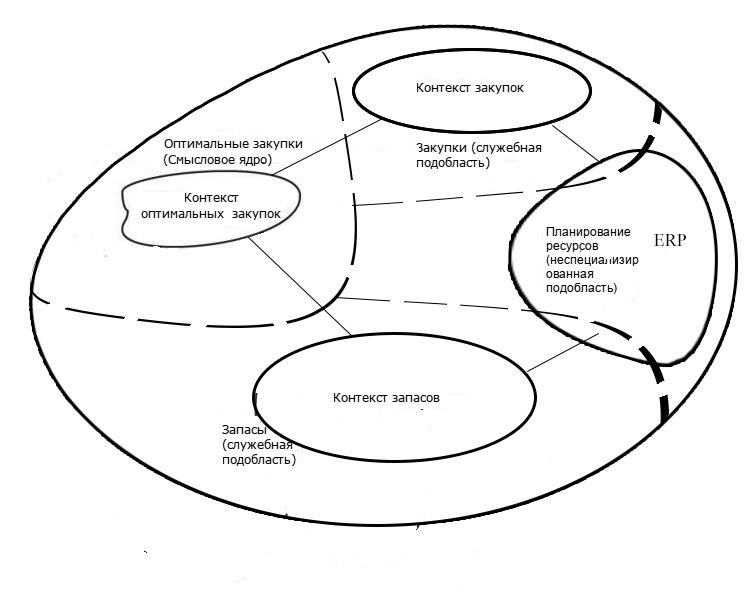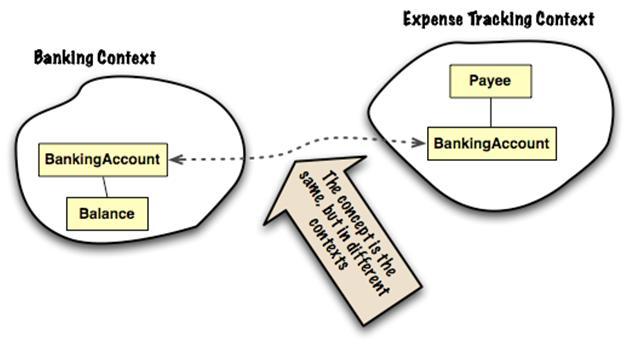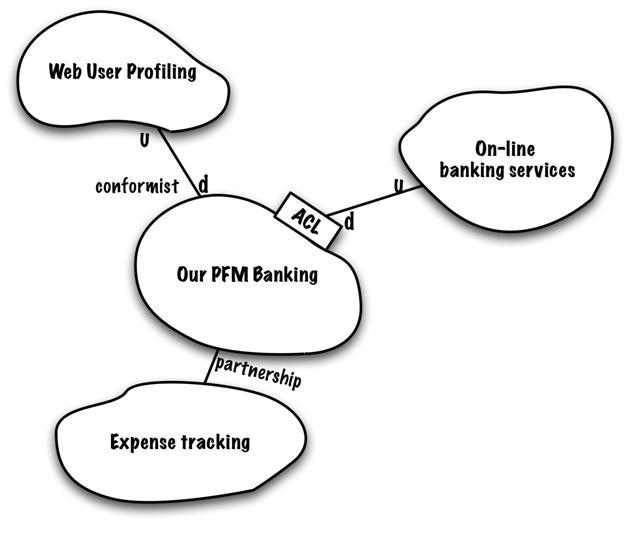Domain-Driven Design: strategic design. Part 1

Hello, habra users! This article will focus on domain-specific software design using, first and foremost, strategic patterns. The second part - about tactical design - read here .
This approach was used by Von Vernon in his book “Implementing Object-Based Design Methods”. The purpose of writing this book: to give developers the opportunity to fly on a DDD plane (as a child, the author often traveled with his family on small planes). The view from the height gives a broader view of the problems of modeling, without letting you get stuck in various technical details. By observing the DDD landscape in this way, one can realize the benefits of both strategic and technical design. Read more - under the cut!
')
The flight is carried out using the tools and templates of strategic modeling, such as: a
Designing using tactical templates, such as, for example, an
The main purpose of using DDD is to obtain a high-quality software model that will most accurately reflect the business goals set. To implement this, it requires the combined efforts of both developers and subject matter experts. Creating a friendly and cohesive team allows you to get a large number of business benefits. The exchange of knowledge between team members reduces the chances of a “secret knowledge” about the model, a consensus is reached between subject matter experts on different concepts and terminology, a more precise definition and description of the business itself is developed.
In order to equalize the developers and domain experts, to make it much easier to exchange useful knowledge about the subject area, the DDD approach suggests applying a common set of terms, concepts and phrases that will be used in communication between team members, and which later will be reflected in the source code of the resultant programs.
Common language
This collective language of terms is called a
- Creating charts of the physical and conceptual subject areas and putting labels on them denoting names and actions. Such diagrams are informal, so there is no point in using formal modeling (like UML).
- Creating a glossary with simple definitions, as well as alternative terms with an assessment of their prospects. Thus are developed stable phrases of a single language.
- Create documentation instead of a glossary. This documentation will contain informal charts or important software related concepts.
- Discussion of ready-made phrases with the rest of the team members who cannot immediately master the glossary or other written documents.
Since the code will be developed quickly enough and it needs to be coordinated with the current version of a single language, then you can later abandon the diagrams, glossary or other documentation.
The most important thing for a developer is the ability to listen to experts, to get the maximum amount of useful knowledge about the subject area. At the same time, experts should also listen to the developers and their wishes. A team learns and grows together if it acts together, gaining a deeper understanding of the business.
I will give a few examples from the book:
In a team, discussing a model for using a flu vaccine in the form of a code, utter a phrase like: "Nurses prescribe flu vaccines in standard doses." Possible scenarios:

Obviously, the first option is far from optimal, the second is better, but does not take into account some important concepts. The final version is most suitable for the task.
It is very important to understand that, within the domain, the meaning of a certain term or phrase can be very different. There is a certain limit within which concepts
single language have a very specific contextual meaning.
Limited context
This conceptual boundary is called the
So, a
- In each limited context, there is only one
. - Limited contexts are relatively small, less than it might seem at first glance.
is large enough only for a single language of an isolated subject area, but no more. - Single means “omnipresent” or “ubiquitous,” that is, the language spoken by team members and which express a separate domain model that the team develops.
- The language is one only within the team working on the project in a single limited context.
- Attempting to apply a
across the entire enterprise, or worse, among several enterprises, will end in failure.
For example, consider the contrast between terms of the summary (assount) in the context of banking services and in the literary context:
Banking Context
The summary maintains a record of receivables and payables that reflect the current financial condition of the client from the bank’s point of view → A summary of current accounts or a summary of savings accounts
Literary context
A summary is a collection of literary expressions about one or more events that have occurred over a certain period of time → Into Thin Air is sold on amazon.com: A Personal Account of the Mt. Everest Disaster
It is not possible to distinguish bulletin types by name. But they can be distinguished only by the names of their conceptual containers, i.e. relevant restricted contexts.

These limited contexts belong to different
In some publishing houses books go through different stages of the life cycle, that is, the book goes through different
- Concept development and proposal for publication
- Contract with the author
- Editorial process management
- Development of a book layout, including illustrations
- Translation of the book into other languages
- Release of paper and / or electronic versions of the book
- Marketing
- Selling a book to resellers and / or directly to customers
- Delivery of copies of the book to resellers or customers
In this case, there is no only way to develop the right book model. For example, before the conclusion of a contract, the title of the book remains uncertain and may change during the editing process. Marketing does not require most of the artifacts of literary and technical editions, with the exception of covers and annotations, and only the name, location of the warehouse, the number of copies, size and weight are needed to sell the book. To avoid confusion, the DDD approach requires the use of separate
In the example above, various
Subject area, subject subdomain, semantic core
It is also necessary to be able to determine the
If a certain aspect of a business is being modeled, which is important, but is not a
This is the basis for strategic design with the DDD approach.
Problem space and solution space
- The task space is part of the
that is needed to create the. This is the combination of theandthat this core should use. - Solution space - one or more
, a set of specific software models. The developedis a specific solution, a representation of the implementation.
The ideal option is to provide a one-to-one correspondence between
As an example, the Von Vernon book provides a

This is only part of the
So, to evaluate the problem space, first of all you need:
- Determine how the strategic
looks like. - What concepts should be considered as part of the
- List
and.
Estimation of the problem space affects the estimation of the solution space. Here it is necessary to think about existing and new systems and technologies. One must think in terms of clearly separable physical
- Analyze existing software for reuse
- Identify funds to be acquired or created
- Examine the integration of these tools.
- Determine how concepts and data of different
overlap - Determine which
contains concepts related to the, and which tactical patterns are used to model it.
Sizes of
Context Map
Following the DDD approach, a certain team must create its own

This Context Map shows the current state of affairs, not what will happen in the future. It is necessary to avoid formalities in the process of creating a
The natural course of events - the coincidence of the boundaries of contexts with the organizational division of the team. People working together share one common context of the model.
After creating a preliminary
There are such relationships between
(Partnership). When teams in twosucceed and fail together, a cooperative relationship arises. They must collaborate in the evolution of their interfaces to accommodate the needs of both systems.(Shared kernel). . , . . ..-(Customer-supplier development). « », .(Conformist). « », . , .(Anticorruption layer). , , «-», . , . , .(Open host service). , . .(Published language).. , , .(Separate ways). , . , .(Big ball of mud). , , ..
An example of development
First, a simple context map is drawn with boundaries and a link between

In these two contexts there are differences in concepts with the same name. For example, Account in Web User Profiling is a user account (login and password). At the same time, for PFM Application (personal finance management), this is a summary describing the current state of the client from the point of view of the bank. Sometimes, as mentioned above, the same concept can be used in completely different ones

For example, PayeeAccount is the same BankingAccount, but with a different behavior (you cannot get a balance). This will create a separate expense tracking context. Also separately, in the example, a context of online banking services is created (on-line banking services) (such services, for example, as a printout of bank statements).

After the first step of creation
Detailed

The context of online banking services is provided by API (it can be an open protocol service and a public language). When this API is changed, the context of personal finance management should immediately change to work with the new API. It should be used
Since the context of web user profiles is used as a ready-made external module and is supplied “as is”, a relationship is established here
In the case of the cost accounting context, the relation
This is a simple example
Conclusion
This article discussed the basic concepts of object-oriented design through strategic patterns:
Of course, after reading this article, much still wants to clarify. To do this, I recommend referring to the aforementioned book by Von Vernon. Also for this there are special communities where you can ask for advice. Tactical same modeling techniques as well as patterns, such as
Thanks for attention!
The article was prepared by: greebn9k (Sergey Gribnyak), wa1one (Vladimir Kovalchuk), silmarilion (Andrey Khakharev).
Source: https://habr.com/ru/post/316438/
All Articles